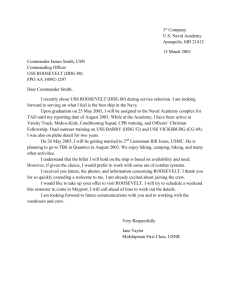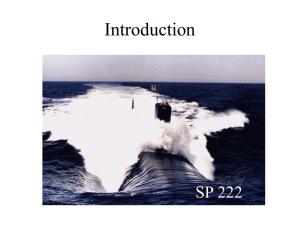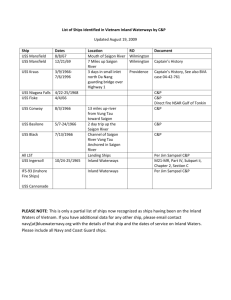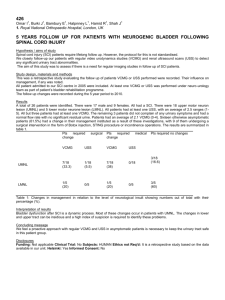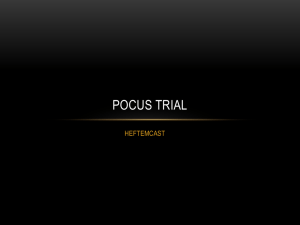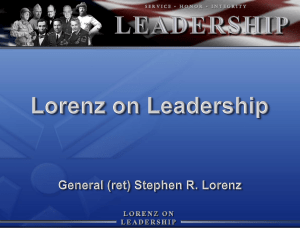International Journal of Naval History
advertisement
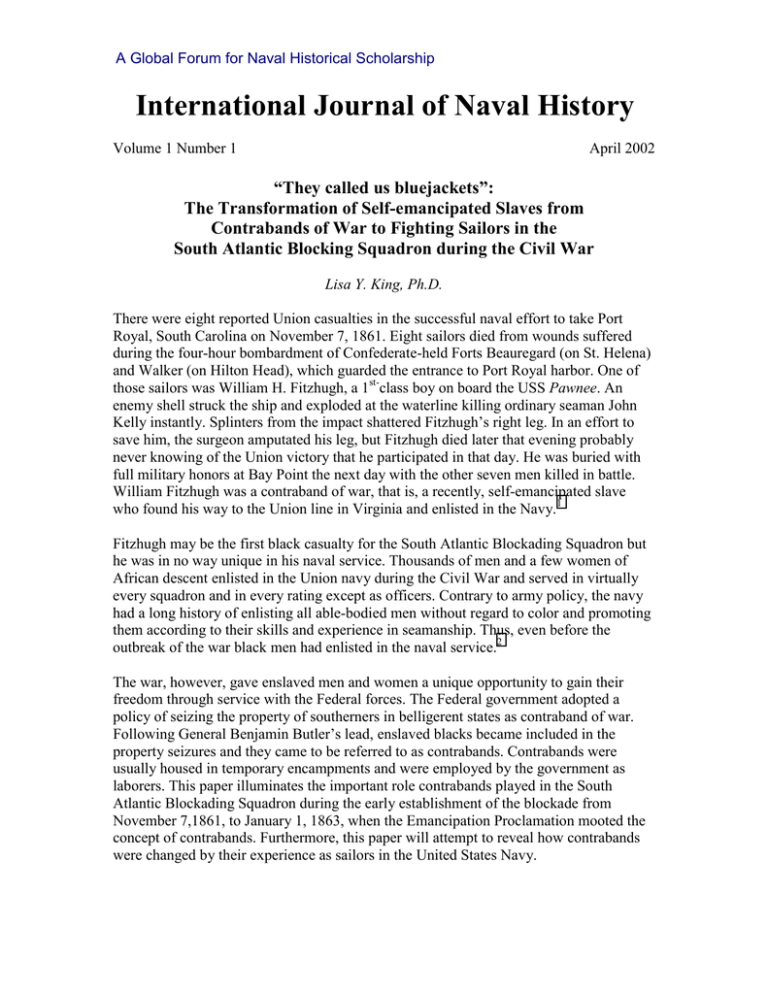
A Global Forum for Naval Historical Scholarship International Journal of Naval History Volume 1 Number 1 April 2002 “They called us bluejackets”: The Transformation of Self-emancipated Slaves from Contrabands of War to Fighting Sailors in the South Atlantic Blocking Squadron during the Civil War Lisa Y. King, Ph.D. There were eight reported Union casualties in the successful naval effort to take Port Royal, South Carolina on November 7, 1861. Eight sailors died from wounds suffered during the four-hour bombardment of Confederate-held Forts Beauregard (on St. Helena) and Walker (on Hilton Head), which guarded the entrance to Port Royal harbor. One of those sailors was William H. Fitzhugh, a 1st-class boy on board the USS Pawnee. An enemy shell struck the ship and exploded at the waterline killing ordinary seaman John Kelly instantly. Splinters from the impact shattered Fitzhugh’s right leg. In an effort to save him, the surgeon amputated his leg, but Fitzhugh died later that evening probably never knowing of the Union victory that he participated in that day. He was buried with full military honors at Bay Point the next day with the other seven men killed in battle. William Fitzhugh was a contraband of war, that is, a recently, self-emancipated slave who found his way to the Union line in Virginia and enlisted in the Navy.1 Fitzhugh may be the first black casualty for the South Atlantic Blockading Squadron but he was in no way unique in his naval service. Thousands of men and a few women of African descent enlisted in the Union navy during the Civil War and served in virtually every squadron and in every rating except as officers. Contrary to army policy, the navy had a long history of enlisting all able-bodied men without regard to color and promoting them according to their skills and experience in seamanship. Thus, even before the outbreak of the war black men had enlisted in the naval service.2 The war, however, gave enslaved men and women a unique opportunity to gain their freedom through service with the Federal forces. The Federal government adopted a policy of seizing the property of southerners in belligerent states as contraband of war. Following General Benjamin Butler’s lead, enslaved blacks became included in the property seizures and they came to be referred to as contrabands. Contrabands were usually housed in temporary encampments and were employed by the government as laborers. This paper illuminates the important role contrabands played in the South Atlantic Blockading Squadron during the early establishment of the blockade from November 7,1861, to January 1, 1863, when the Emancipation Proclamation mooted the concept of contrabands. Furthermore, this paper will attempt to reveal how contrabands were changed by their experience as sailors in the United States Navy. A Global Forum for Naval Historical Scholarship International Journal of Naval History Volume 1 Number 1 April 2002 Contrabands were an integral part of the Union’s naval mission in three ways. First, they provided invaluable intelligence information about the Confederates’ positions and strength. Second, as pilots, they guided navy craft deep into enemy territory navigating inland waterways for which the Coastal Survey pilots had limited or no knowledge. Finally, they enlisted in the navy serving in all capacities on board ships and in boat crews doing picket duty, reconnaissance and foraging, and fighting as bluejackets in naval brigades. Not long after Union forces secured a foothold on Port Royal Island, enslaved people along the South Carolina coast and coastal inlets fled to the safety of the naval vessels. The plantation owners had abandoned the Sea Islands near Port Royal leaving nearly 12,000 of their human chattel virtually free.3 As Federal craft scouted around St. Helena, Hilton Head, Ladies and Edisto Islands they found only welcoming blacks some of whom were eager to work for them while others wanted to remain on their home plantations and grow crops for themselves.4 The South Atlantic Blockading Squadron under command of Rear Admiral Samuel F. Dupont set up headquarters at Port Royal. Although the defeat of Confederate forces had been a navy victory, the occupation of the land fell under the army’s purview. Thus, Brigadier General Thomas W. Sherman (known as the other General Sherman) established his command on Hilton Head Island. In fact, the Federal strategy to bring the rebellious states of South Carolina, Georgia, and Florida back into the Union fold was designed as a combined naval-military operation. The cooperative scenario that unfolded at Port Royal on November 7 was repeated down the coast from Fort Pulaski, Georgia, to Fernandina, Florida—army occupation followed an initial naval assault executed by marines and armed seamen (known as bluejackets) covered by the big guns of Navy vessels. Over the next few months, naval vessels headed north from Port Royal to blockade Georgetown, South Carolina and to strengthen the blockade of Charleston; and south to complete the blockade of Georgia and the East Coast of Florida down to Cape Canaveral. Approximately 48 vessels were assigned to the squadron by year’s end. The number of vessels increased dramatically, so much so, that by the time the joint Army-Navy assault on Ft. Wagner occurred in September of 1863 the squadron had just under 100 ships. The increased naval presence facilitated an increase in the contraband population on land and at sea.5 By the middle of 1862, major contraband camps, housing thousands of self-emancipated individuals, existed on Edisto Island, Hilton Head, and Port Royal in South Carolina, St. Simons Island in Georgia, and Fernandina in Florida. Ships at anchor off the coast or reconnoitering inlets became magnets for fleeing blacks. Some of the earliest contrabands A Global Forum for Naval Historical Scholarship International Journal of Naval History Volume 1 Number 1 April 2002 encountered, outside the Port Royal area, offered valuable military intelligence. For example, on December 9, 1861 blacks who came on board the Pawnee. near Edisto Island informed Commander Percival Drayton that Confederates were at the entrance to Mosquito Creek, a place up the Ashepoo River where the inland route to Charleston commenced. On his approach to Mosquito Creek with four vessels, the rebel pickets retreated.6 About ten days later, as the Pawnee reconnoitered the Edisto River a few blacks came on board and informed Commander Drayton that 500 confederates were encamped at Rockville on Johns Island. Drayton landed with a force of 50 marines and bluejackets to survey the area but found the encampment recently deserted. The naval force confiscated a boat loaded with cotton and 150 blacks collected on the Pawnee as well as on the three other ships that had accompanied him up the river.7 Foraging expeditions became more fruitful due to the knowledge contrabands possessed about plantation inventories. Lieutenant Nicholson commanding the USS Isaac Smith confiscated bushels of potatoes and other goods from a plantation up the Ashepoo River. He was guided on this expedition by contrabands who had recently been enslaved there.8 Reconnaissance in enemy territory put the lives and property of Federal forces at risk. Contrabands, who had been employed in placing obstructions in waterways, pointed them out to unknowing Navy personnel. Thus, Navy vessels were less likely to get snagged in inland waterways risking ambush or capture. Contrabands had informed Nicholson the enemy had obstructed the river about ten miles north of Fenwick Island on the Ashepoo River before his trip there.9 Commanders used contraband intelligence to strategize against the enemy more effectively. For example, at Bull’s Bay, South Carolina, the USS Restless picked up a yawl boat containing two contrabands that had recently escaped from the schooner on which they worked. They reported to the commander that about twenty-five schooners and sloops were engaged in supplying Charleston with rice and other food supplies through an inland route between Santee and Georgetown. The contrabands Harry Reed and William Maxwell guided the Restless through the Inland Passage, whereby in two days the ship successfully captured four vessels laden with rice.10 On another occasion, a contraband named Gabriel disclosed the route by which ships moved in and out of Charleston, “by Maffitt’s channel and pass north of Rattlesnake Shoal, close by the land.” After receiving the information, Commander J. B. Marchand the senior officer in charge of the blockade off Charleston changed the position of one of the blockading ships to better intercept blockade runners.11 A Global Forum for Naval Historical Scholarship International Journal of Naval History Volume 1 Number 1 April 2002 Contrabands also gave information about Confederate troop movement and firepower. The commander of the USS Bienville informed Dupont that 15 blacks had escaped from Charleston on April 27, 1862, in a boat intercepted by the Bienville. “One of the contrabands has been in the employment of General Ripley, commander in chief there. He reports that the Stono River and Wappoo Creek [where it connects with Charleston] is defended by eight batteries, one of which has sixteen guns and the other twenty four, and about 500 torpedoes are sunk in the channel.” The contraband named Allen Davis further reported that troop strength in the city was diminished because some regiments were sent to Virginia.12 Although Robert Smalls is best known for piloting the CSS Planter out of Charleston harbor under the watchful eye of the Confederates, the intelligence he gave to the Federals proved to be of far greater value. Smalls reported that the rebel forces had abandoned the Stono River, a critical backdoor route into Charleston. Finding his information to be correct, Dupont ordered Commander Marchand to cross the bar with three gunboats. This breech eventually led to the Federals’ landing forces on Folly and Morris Islands. Smalls also corroborated information about Confederate troop strength and firepower in the Charleston area. So impressed was Dupont with him that he wrote to Secretary of the Navy, Gideon Welles, “This man Robert Smalls, is superior to any who has yet come into the lines, intelligent as many of them have been. His information has been interesting, and portions of it of the utmost importance.”13 Doubtless Smalls’ information along with other contraband intelligence boosted Dupont’s confidence enough to plan an attack on Charleston in the coming months.14 The intelligence that the contrabands provided was relied upon and sought after from the highest link in the squadron’s chain of command. Admiral Dupont instructed his commanders to take care in collecting the contrabands and providing for their comfort but to make sure to also continue “with the acquisition of all information from them, which may be of public utility.”15 As exemplified by Robert Smalls, who Dupont hired to pilot the Planter, the contrabands’ knowledge of the hundreds of small inlets along the Georgia and northern Florida coasts proved to be particularly beneficial to the squadron. From the inception of the plan to establish a Federal foothold in Confederate territory, there was awareness that this area had a “peculiar formation [barring the mainland] from the open ocean by several islands which are divided from each other by inlets.” “[L]ocal knowledge of the sounds and inlets” and knowledge of the times and heights of tides was needed to navigate their vessels safely through them.16 About two weeks after the Federal flag was hoisted at Port Royal, Dupont reported to Gideon Welles that the Stars and Stripes had been planted in the state of Georgia at Tybee Island. The Federals had their sights on Fort Pulaski a formidable structure that A Global Forum for Naval Historical Scholarship International Journal of Naval History Volume 1 Number 1 April 2002 controlled traffic in and out of the Savannah River thereby restricting a Union approach from the sea to that city.17 The Confederates destroyed lighthouses and removed all buoys and channel markers making navigation all the more difficult. During the initial reconnaissance of the sounds, pilots from the United States Coast Survey assisted the Navy ships; however, their knowledge seemed limited to the coast.18 The need for knowledgeable pilots became more critical as navy vessels pushed further inland. Commander N. Collins of the USS Unadilla expressed his need for pilots for his three gunboats in order to patrol Wright’s River, in Georgia.19 Lieutenant Semmes of the USS Wamsutta also complained of his need of a good pilot so he could reach a higher point on the Newport River in Georgia.20 And Lieutenant A. C. Rhind, commanding the USS Crusader, blamed the partial failure of an expedition up the Paw Paw River on the ignorance of the pilot in those waters.21 Contraband pilots, with their collective knowledge of the inland waterways from Bull’s Bay, South Carolina to Fernandina, Florida, stepped in to fill the void. Because water transportation remained the most popular means of shipping crops to market before the war, the enslaved workers had easy access to and possessed knowledge of the waterways because of their experiences as pilots, sailors, and watermen.22 In May 1862, the USS Gem of the Sea picked up five contrabands off Georgetown who had escaped from the Arthur Blake plantation. The commander of the vessel remarked that one of the contrabands named Captain Blake “is a good pilot of all the inland creeks and rivers from the South Santee to Savannah.”23 Similarly, the USS Keystone State picked up a fisherman named Prince Coit off Georgetown and found that he was useful as a pilot for the waters in that area.24 The Bienville had a group of fifteen contrabands on board, one of whom had worked on a pilot boat for twelve years. Of the other men, the commander stated, “I understand there are other men among the party equally well acquainted with the channels and harbor.”25 The skills of these men were immediately tested then put to good use. A “colored” pilot on the USS Flag navigated the vessel up the Tybee River, in Georgia and the commander of the ship was impressed that the contraband was “thoroughly acquainted with the channel.”26 One black pilot identified only as Prince seemed knowledgeable of many waterways. He brought the USS Uncas across the bar off Fernandina, which allowed an expedition to proceed up the St. John’s River in Florida. One month later, the commander of the USS Albatross remarked on how much he trusted his navigational skills to get an expedition up the Black River in South Carolina to destroy a bridge.27 A Global Forum for Naval Historical Scholarship International Journal of Naval History Volume 1 Number 1 April 2002 Admiral Dupont was also impressed with the local knowledge of inlets the contraband pilots exhibited. He sent one named William Jenkins along with Commander John Rodgers on an expedition up Wright’s River to find another approach to Savannah.28 Dupont requested Jenkins’ skills for other occasions as well.29 When good pilots were found the wise commander enlisted them.30 In addition to pilots, it became common practice to enlist contrabands as boys (a traditional Navy rating for apprentices), throughout the squadron. As early as September 1861, the Navy Department adopted a policy to enlist contrabands out of a growing concern for their numbers at land stations and on war ships.31 As the summer season approached, Dupont strongly supported this policy believing blacks were immune from tropical diseases that decimated white crewmembers.32 In total over one thousand men enlisted in the squadron from South Carolina, Georgia, and Florida over the duration of the war. Although a precise number may never be known about 200 men enlisted during 1861 and 1862.33 The extant muster rolls of naval vessels during the years 1861 and 1862 are sketchy at best. Record keeping for personnel on board ships improved dramatically after 1863. Therefore, it is possible that the number of contrabands enlisted before 1863 is far greater than the existing records reflect. The muster rolls of some ships have not survived. On others, the contraband presence was simply ignored even though they were clearly recorded in the deck logs of ships. On some ships, however, the names of contraband were recorded some with and some without enlistment dates. For example, the muster rolls of the USS Housatonic list twenty contrabands as of January 1, 1863. The place of enlistment reflects where the men were picked up. In this case the places of enlistment were “South Santee” river, “off Charleston” harbor in South Carolina, St. Simons Island in Georgia and St. John’s river or Fernandina in Florida. More interesting is that seven of the twenty men do not have enlistment dates, yet stay on the muster roll through 1864. This suggests that not all contrabands enlisted; some remained on board ships as contract employees similar to their counterparts at land stations.34 Of the enlisted men, the majority are rated as boys with the exception of the pilots. Five pilots were rated as seamen or as pilots on the rolls of various ships. Cupid Wilson enlisted as a seaman at St. John’s in December 1862. His name appears on several different ships reflecting the nature of a pilot’s work. Pilots were transferred between ships often as the need arose.35 Similarly, Charles Tatnall’s name appears repeatedly on different ships. He enlisted on November 1862 at St. Simons.36 The USS Norwich maintained Frederick Gardiner, a river pilot from Jacksonville, Florida, enlisted January 1862, on its muster rolls for two years. The two other pilots appear on the muster rolls of ironclads USS Nahat and USS Nantucket without enlistment dates.37 A Global Forum for Naval Historical Scholarship International Journal of Naval History Volume 1 Number 1 April 2002 Of the 195 contrabands enlisted as boys in 1862, one of the earliest John Ellard enlisted at Brunswick, Georgia, on March 4. He served on the Norwich with ten other contrabands; and one of the later enlistees Boston Taylor was picked up by the USS Uncas December 14 on the St. John’s river and transferred to the USS Potomska where he served with four other contrabands. On average, the contraband presence was minimal, most ships having three to six. The USS Madgie had sixteen out of a total crew of forty-five. Admiral Dupont’s flagship the USS Wabash had seventeen contraband included as part of its 568-man complement. 38 Officers excepted, two ships in the squadron had majority black crews. The USS Valparaiso, a store ship, stationed at Port Royal had a 46-man crew of which 43 were contraband enlistees. Similarly, the USS Vermont, a receiving ship, also stationed at Port Royal filled its complement of 144 men with 143 men of African descent. These two ships were the exception; other ships in the squadron had interracial crews, the majority of whom were of European ancestry.39 The 65-man bark Gem of the Sea had eight contrabands enlisted as boys before 1863. Of the five contrabands picked up off Georgetown in May of that year, four had enlisted. Robert, Prince, Michael, Jack and Captain Blake, the pilot, were transferred to the Norwich, where with the exception of Captain, they served until the closing months of the war. Re-enlisting as landsmen in 1864, three of the Blakes were promoted to ordinary seamen the following year, while Robert was promoted to seamen.40 Similarly, two contrabands who enlisted on the Potomska as boys in March 1862 were promoted to Officers’ Steward and ordinary seamen by October of that year.41 On the USS Ladona Thomas Mandingo and Nelson Anderson were enlisted in 1862 as ordinary seamen suggesting they possessed some maritime knowledge and experience. They were both promoted to seamen when they re-enlisted in 1864. Nelson Anderson was later promoted to Captain-of-the-Hold, a petty officer position, while serving on this ship.42 In order to attain these ratings these men had to prove themselves skilled and able seamen to the officer’s satisfaction. More importantly they had to prove themselves the equal of their peers by following the rigorous routines, adhering to the strict discipline and suffering the many hardships endured by all of the ship’s crew. What does this suggest about the transformative process that unfolded in these men? How were they changed by their naval experience? This transformative process developed on many levels. On the macro level, the transformation started with the flight from enslavement. Each escapee transformed himself from the legally defined state of chattel property to contraband of war when he reached a Union vessel. However, this new definition was not permanent, for contraband lingered in a conditional limbo, no longer enslaved, perhaps, but neither were they free. With enlistment came the next stage of change, freedom and most importantly recognition as legal beings—as men. A Global Forum for Naval Historical Scholarship International Journal of Naval History Volume 1 Number 1 April 2002 On the micro level, the transformative process continued for each man on a personal level with his day-to-day interactions with others onboard ship. For some men like 18- and 19year-old Gabriel and Plenty Seneca enlistment gave them not only a new social status but also transformed how they identified themselves. Both men enlisted on board the USS Seneca in December 1862 and took as their surname the name of the ship upon which they had been reborn as free men. Other men dropped their enslaver’s surname for the name of their father or some other relative. For many, creating a new identity of their own choosing was the first step in asserting themselves as free men.43 Men just recently escaped from slavery were exposed to a different but somewhat familiar regiment at sea. Coming from a controlled life of hard work on plantations may have eased their adjustment to the strict discipline and daily drudgery on board ships. They were uniquely conditioned from birth to follow the orders of white men without question. However, with continuous exposure to social conditions in the Navy they realized they were, basically, treated the same as white men of the same rank and rating. Over time their perspectives on race relations were surely altered. For example, on the Pawnee, the ship on which contraband William Fitzhugh was killed during the battle of Port Royal, ten contraband enlistees and thirty freeborn, northern blacks served in the ship’s 150-man crew. Fighting, almost a natural consequence of men crowded into cramped quarters for extended periods, was a routine occurrence. The combatants were always punished the same regardless of the color of their skin. George Dixon a 28-yearold mariner from Baltimore, Maryland, was confined twice in double irons with a restricted diet of bread and water for fighting a white sailor on one occasion and a black sailor from Philadelphia a few months later. The two men with whom he fought endured the same punishment as he.44 On other ships, punishment was also impartial. On the USS John Adams two white sailors were confined in double irons for fighting the ship’s cook, Samuel Quabner, a contraband enlistee. On the Wabash a white sailor was confined in solitary for three days on bread and water for striking a contraband. Doubtless occurrences like these and many others documented in the ship’s logs had a profound and lasting psychological effect. Extended exposure to this type of equitable treatment surely forced the men to readjust their thinking along the lines of social and political equality.45 As the war continued a few men even tested their mettle by challenging authority figures. Although punishment for insubordination to officers was rarely found in the early logs in regards to contrabands, four men who had enlisted as contraband in 1862 were confined in the brig on the Vermont for this offense by 1864. This suggests once again an assertion of their will as free men. Each act of defiance doubtless defining their manliness and also revealing their willingness to suffer the consequences of their actions like any other man.46 A Global Forum for Naval Historical Scholarship International Journal of Naval History Volume 1 Number 1 April 2002 Another area in which the contraband enlistees asserted themselves was in forming friendships. When not on duty men socialized below decks or ashore on liberty. On the ship, leisure activities were usually limited to eating, smoking, and drinking the daily “grog” ration and sometimes music. Gambling although illegal did occur. Fishing also occurred on some ships.47 Besides fighting, drinking seemed to be the most popular social activity. In fact, drunkenness became such a problem in the squadron that the grog ration was discontinued after August 31, 1862.48 Still liquor found its way onboard and the men chose with whom they wanted to share this illicit activity. When spirits were available, some contraband enlistees indulged in drinking to excess with their comrades. On one such occasion March Spaulding a 24-year-old from Georgia was thrown into the brig with three of his drinking buddies: a freeborn black from Boston and two white sailors. This suggests once again not only a willingness to circumvent the Navy’s regulations, but on a broader level, to also break with the South’s social etiquette which was rigidly defined along the color line. Leisure time was, however, brief and infrequent. Days were filled with long hours of tedious work sometimes punctuated by intermittent encounters with the enemy. All hands were responsible for maintaining the ship’s seaworthiness. And it was in these day-to-day activities that contraband enlistees had the greatest opportunity to complete their transition to skillful seamen and warriors. Sailors were responsible for scrubbing the wooden decks with sand and rocks (an activity called holystoning) to keep the surface smooth and splinter free. They also scraped masts, polished brightwork (the brass), and painted the interior and exterior of their ships regularly. Seamen trained boys in reefing (taking in) and unfurling (letting out) the sails. All hands participated in storing coal and supplies in the ship’s hold. When needed, details of men were sent ashore in the launches and cutters to get water or to chop and haul wood. Each sailor was responsible for cleaning his own clothes and hammock at least once a month but on some ships they were cleaned more often. These were the activities all sailors shared just to keep their vessel afloat, clean and livable.49 However, battle readiness was a crew’s top priority. Practicing general quarters and drilling on the big guns, with small arms and with cutlasses was a daily routine that kept the men fit for battle. All hands participated in these drills. The men competed by division to see how quickly they could deploy their cutters or launch for landing parties. Men who were late to their boats were punished. Landing parties played an integral part of the naval offensive as ships patrolled along the Southern coast and inland waterways throughout the duration of the war.50 After all, it was a company of bluejackets and marines that first landed and planted the American Flag at Fort Walker on Hilton Head. And it was a landing party of bluejackets and marines who planted the flag on Tybee Island, Georgia and secured Fernandina, A Global Forum for Naval Historical Scholarship International Journal of Naval History Volume 1 Number 1 April 2002 Florida in March of 1862. It was the small-arms-men of the Pawnee that first reconnoitered Jacksonville, St. Mary’s, and Mayport in Florida. By the end of March 1862, the Navy had control of the Southern coast from Port Royal to Fernandina, Florida. And they maintained control by patrolling incessantly the inland waterways, shelling enemy batteries and landing armed men to rout the enemy on numerous occasions. By the end of May of that same year, Navy gunboats also controlled the Stono River, a backdoor route to Charleston. Contraband enlistees participated in these naval successes and they were exposed to all of the dangers of ambush and capture as were their white shipmates.51 Through these experiences of engaging the enemy, the exposure to danger, and participation in the routines of shipboard life, contraband enlistees metamorphosed into fighting bluejackets. Going ashore as part of a boat’s crew or landing party possessed an added risk for black sailors. Early on in the war blacks captured by Confederates were not treated as prisoners of war but rather as runaway slaves and faced death by hanging rather than confinement in a prisoner of war camp. One pilot had already suffered that fate. On March 22, 1862, a black pilot from the USS Penguin on an expedition at Mosquito Inlet, Florida was ambushed when the boats landed near Smyrna. Eight men were killed and seven wounded including the pilot. Some men escaped back to the ships but the pilot was captured along with some of the other wounded and the pilot alone was later hanged.52 Despite this danger black men continued to perform their duty ashore on expeditions. Prince Wilson a member of the crew of the USS Vermont served on several different gunboat expeditions in rivers. He sustained wounds when his boat was fired upon on one expedition up the Stono River in South Carolina.53 Similarly, Charles Godey of the Madgie was wounded when his boat was ambushed while going ashore to investigate a white flag. One of his friends was killed during this engagement. Of this event he later recalled: It was the custom for contrabands to signal the ship to be taken aboard. The captain would send a boat and crew and bring them aboard. I served several times as one of a crew. One morning in answer to a signal a crew boat was sent. I was one of the crew. On arriving within rifle range of the point where the signal was made the boat and crew were fired upon. One man was killed and several wounded myself among the fallen.54 Some contraband enlistees having steeled themselves after months or years of service in the Union wartime navy served in naval brigades. In March of 1863, both Prince Blake and his cousin Michael, now seasoned crewmembers of the Norwich, served in a naval brigade that supported the 1st and 2nd South Carolina Volunteers in taking Jacksonville, A Global Forum for Naval Historical Scholarship International Journal of Naval History Volume 1 Number 1 April 2002 Florida. During an engagement at Cedar Creek Prince Blake was wounded when the enemy rushed out of a dwelling and opened fire on the advancing squad.55 In July of 1863 Adam Collins and Isaac Mack from St. Simons, Georgia, served on the O. M. Pettit and participated in the naval bombardment of Ft. Wagner on Morris Island. And in November 1864, they both served in a naval brigade at the battle of Honey Hill. Additionally, men from the Vermont were pulled to make up a brigade for this battle. George Singleton, Jacob Simmons, Thomas Morris, Thomas West and Stephen Holmes all fought at Honey Hill. “They called us bluejackets and sent us to the battle of Honey Hill and also to a fight on James Island,” Holmes recalled, “All the ships furnished men to these battles.”56 Thus, through their perseverance to duty, their bravery in the face of the enemy and their willingness to sacrifice their lives, these formerly enslaved men permutated from contraband of war to able warriors. They were forever changed by their experience in the Civil War. For their blood sacrifice, they earned the right to be remembered as fighting bluejackets in the United States Navy. 1 Official Records of the Union and Confederate Navies in the War of the Rebellion, Series I, vol. 12 (Washington: Government Printing Office, 1902), 264. (Hereafter cited as ORN.) 2 See Joseph P. Reidy, Roger A. Davidson, Lisa Y. King, et al., “The Hidden Civil War: Men of African Descent in the United States Navy,” unpublished paper given at the African-American Civil War Memorial Symposium at Howard University, September 11, 1996. Reidy estimated 18,000 black sailors served. See also David L. Valuska, The AfroAmerican in the Union Navy: 1861–1865 (New York: Garland Publishing, Inc. 1993). Valuska estimated 10,000 black sailors served in the war. 3 Ira Berlin, Barbara J. Fields, Thavolia Glymph, Joseph P. Reidy, and Leslie S. Rowland, eds., Freedom A Documentary History of Emancipation, 1861–1867; Series I, Vol. 1: The Destruction of Slavery, 104–105. 4 ORN 12: 273. 5 ORN 13: xvii–xviii; 14: xvii–xviii. 6 ORN 12: 388. 7 Ibid.: 412. 8 ORN 12: 392. 9 Ibid. Contrabands pointed out the dangers of the Newport River in Georgia allowing some naval vessels to proceed up the river about 15 miles to within a mile of Dorchester unobstructed. ORN 12: 776. A Global Forum for Naval Historical Scholarship International Journal of Naval History Volume 1 Number 1 10 April 2002 ORN 12: 546–48. One month later, the Restless captured three more vessels at that same spot. ORN, 12: 667. 11 Ibid.: 784–85. 12 ORN 12: 784–85. Early warnings about troop movements doubtless saved lives by allowing the Federals the time needed to prepare for enemy attacks. Union forces were able to repel Confederates on Edisto Island because of intelligence offered by contrabands. In a report to Admiral Dupont dated March 29, 1862, the commander of the USS Dale explained, “A large number of contrabands just arrived assure me that the rebel forces have abandoned Willistown, on the mainland, and moved to Jehosse Island, where heretofore they have only kept a small picket.” A combined and ready Federal force engaged the enemy the next day when they attacked and drove them back to the mainland. Ibid.: 675. 13 ORN 12: 807,820–21. 14 ORN 13: 50. 15 ORN 12: 802. 16 The Sounds were the Tybee, Wassaw, Ossabaw, St. Catherine’s, Sapelo, Doboy, Altamaha, St. Simons, St. Andrews and Cumberland. Ibid.: 201–203. 17 Ibid.: 326. 18 Ibid.: 395. 19 Ibid.: 641. 20 Ibid.: 776. 21 Ibid.: 789–91. 22 Jeffrey W. Bolster, Black Jacks: African American Seaman in the Age of Sail (Boston: Harvard University Press, 1996), 55–56. 23 ORN 12: 734–35. 24 Ibid.: 678. 25 Ibid.: 787. 26 ORN 12: 469. 27 ORN 13: 123. 28 Also on the expedition were a Captain Wilson of the Topographical Engineers and the two Coast Survey pilots, Acting Masters Godfrey and Haffords. ORN 12: 491. 29 See Dupont’s request for Jenkins to come to Port Royal from the Savannah River, ORN 13: 65. See also other requests in deck logs of USS Wabash for January 18, 1862, and July 8, 1862, Record Group 24, National Archives, Washington, DC. (Hereafter referred to as RG 24, NA.) 30 Commander John Gillis of the USS Seminole thought very highly of the contraband Isaac Tatnall because of his navigational skills. Gillis wrote to Dupont, “I presume there will be no irregularity in shipping Isaac (as ordinary seaman), a colored refugee, or contraband on account of his knowledge of inlets along the coast.” ORN 12: 460. Similarly, Lieutenant Daniel Ammen, commanding the USS Seneca at St. John’s River in Florida found a knowledgeable contraband onboard his ship and enlisted him. ORN 13: 64–65. A Global Forum for Naval Historical Scholarship International Journal of Naval History Volume 1 Number 1 31 April 2002 Officers were authorized to enlist them in the naval service “under the same forms and regulations as apply to other enlistments. They will be allowed, however, no higher rating than ‘boys’ [a naval rating for apprentices] at a compensation of $10 per month and one ration a day.” In April 1862, Secretary Welles, reflecting popular medical belief of the period that blacks were somehow immune to tropical diseases and fever, insisted on using contrabands as an “acclimated” labor force in the navy as the “sickly season” approached the Southern coast. He required his flag officers to enlist them “freely in the Navy” and compensate them accordingly. And in December of the same year he allowed the commanding officers to advance qualified contrabands to other ratings on the ship, such as ordinary seaman, seaman, fireman or coal heaver. See ORN 6: 252; 7: 294, 376; 8: 309. 32 Although contrabands were onboard ships, enlistment of them in the squadron did not seem to increase until Dupont issued General Order No. 11 on May 15, 1862, to increase the number of “acclimated persons” for duty in engine rooms and boat service or any duty that involved exposure to sun and heat as the “sickly season” approached the coast. Northern crews were susceptible to fever in the semi-tropical environs of the Southern coast causing manpower shortages, which Dupont hoped to avoid with this order. ORN 13: 5. 33 According to muster rolls, 632 men enlisted from South Carolina; 338 from Georgia; and 211 from Florida. Source: African-American Civil War Sailor database at Howard University. 34 See muster rolls from USS Housatonic dated January 1, 1863. RG 45, NA. 35 See muster rolls from USS E. B.Hale, USS Ottowa and USS Uncas, RG 45, NA. 36 See muster rolls from USS Paul Jones and USS Potomska, RG 45, NA. 37 One pilot was clearly a contract employee for there is an entry that indicates he was “paid at sea.” The other pilot Gabriel Pickney may be the same Gabriel picked up by the USS Bienville in April 1862. If so, he was still working as a pilot when the USS Nantucket recorded his name on its March 31, 1864 roll. See muster rolls of USS Norwich, USS Nahat and USS Nantucket, RG 45, NA. 38 See muster rolls from USS Norwich, USS Uncas, USS Potomska, USS Madgie, USS Wabash, RG 45, NA. 39 See muster rolls from USS Valparaiso dated July 13, 1863 and USS Vermont dated July 13, 1863, RG 45, NA. 40 See muster rolls from USS Gem of the Sea and USS Norwich, RG 45; Captain Blake was discharged December 21, 1862; see deck log of USS Norwich for December 21, 1862, RG 24, NA. 41 See muster rolls from USS Potomska dated March 1862, RG 45, NA. 42 See muster rolls from USS Ladona, RG 45, NA. 43 See Depositions of Gabriel Seneca, Prince Wilson alias Prince Blake, and Stephen Polite alias Stephen Blake in the pension files of named men, RG 15, NA. 44 See muster rolls from USS Pawnee, RG 45; see also deck logs of USS Pawnee for January 19, 1862, and September 9, 1862, RG 24, NA. A Global Forum for Naval Historical Scholarship International Journal of Naval History Volume 1 Number 1 45 April 2002 See deck logs of USS John Adams for October 8, 1863; and of USS Wabash for January 21, 1863, RG 24, NA. 46 See deck logs of USS Vermont for July 7, 1864, RG 24, NA. 47 See deck logs of USS Pawnee for December 31, 1861, January 20, 1862, March 13, 1862, and April 3, 1862; and of USS Wabash for September 4, 1861, RG 24, NA. 48 See deck log of USS Wabash for August 31, 1862, RG 24, NA; see also Letter from Commander Percival Drayton to Flag-Officer S. F. Dupont dated May 11, 1862 complaining of the increased occurrences if drunkenness in the squadron in ORN 13: 3–4. 49 See deck logs of USS Wabash for September 9, 1861, and October 4, 1861, and of USS Pawnee for April 19, 1862, July 12, 1862, July 23, 1862, January 4, 1862; of USS Potomska for July 10, 1862; and of USS Norwich for May 29, 1862, July 15, 1862, and May 13, 1862, RG 24, NA. 50 See deck logs of USS Norwich dated April 30, 1862; of USS Potomska for February 5, 1862; of USS Pawnee for October 23, 1862; and of USS Wabash for October 25, 1861, and November 21, 1861, RG 24, NA. 51 See deck logs of USS Wabash for November 7, 1861, and March 2-4, 1862; of USS Pawnee for March 13, 1862; and of USS Potomska for March 11, 1862, RG 24, NA; see also ORN 13: 54. 52 See ORN 13: 64–65 and 83; see also deck logs for USS Wabash dated March 22–23, 1862, RG 24, NA. 53 Deposition of Prince Wilson, 8/31/1904, pension file of Prince Wilson alias Blake, RG 15, NA. 54 Deposition of Charles Godey, 5/23/1901, pension file of Charles Godey alias Mitchell, RG 15, NA. 55 Deposition of Robert Blake, 6/24/1891, pension file of Prince Jenkins, alias Blake, RG 15, NA. 56 See deposition of Adam Collins, pension file Adam Collins; see also deposition of Stephen Holmes, pension file Stephen Holmes; and deposition of George Singleton, 6/8/1901, pension file of George Singleton, RG 15, NA.
